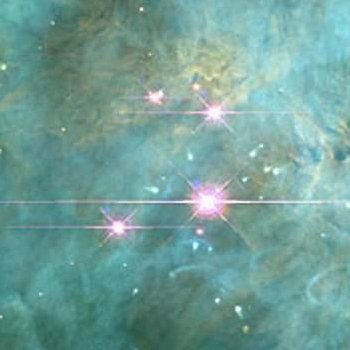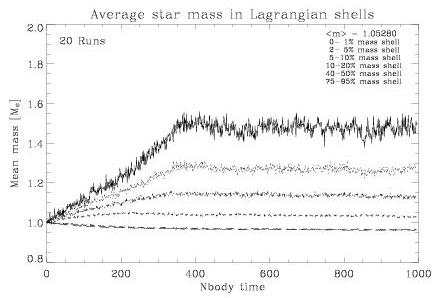
The core of the Trapezium showing the four energetic massive stars and a plethora of Sun-like stars with surrounding extended emission.
| Stars are usually formed in the community of clusters, which may range from small associations of some tens of stars to very dense and rich ones containing some thousand stars such as the Trapezium in the Orion Nebula Cloud. The most massive stars are often found near the cluster centres, indicating an undergone process of mass segregation. There are two different physical explanations for the mechanism: On one hand side, the fragmentation of a star forming cloud occurs with tendency of the high mass stars forming near the bottom of the potential well due to the accelerated accretion of more and more gas; they remain near their place of birth at the cluster centre from the early stages of the star forming scenario. On the other hand, massive stars may form elsewhere and sink to the centre through two-body relaxation after the formation process has already finished. Both mechanisms are reasonable, but they should differ in the time scales until the cluster achieves its observed radial mass stratification. Dynamical models are challenged to answer this question by comparison with models of star formation. |

The core of the Trapezium showing the four energetic massive stars and a plethora of Sun-like stars with surrounding extended emission. |
In the idealized case of two different masses present, two parameters govern the segregation process: The fraction of all heavy masses to the total cluster mass, q, and the ratio of the individual particle masses, \mu. The two parameters are linked by the formula:


The graphic shows the evolution of the average mass in specified spherical shells around the cluster centre. The increase of the mean mass in the innermost shells is clearly visible, indicating a high fraction of heavy masses. This simulation was performed with two types of stars: The heavy ones were twice as massive as the light ones (\mu = 2.0), and their total fraction was 10% of the cluster's mass (q = 0.1). The data at each time point were averaged over 20 runs differing by a random initial setup of positions.
Last modified: 2001, Nov 20